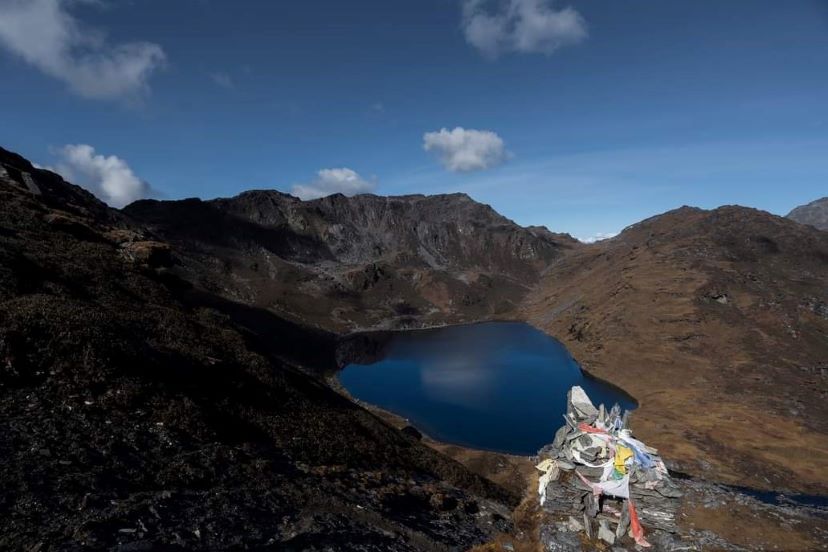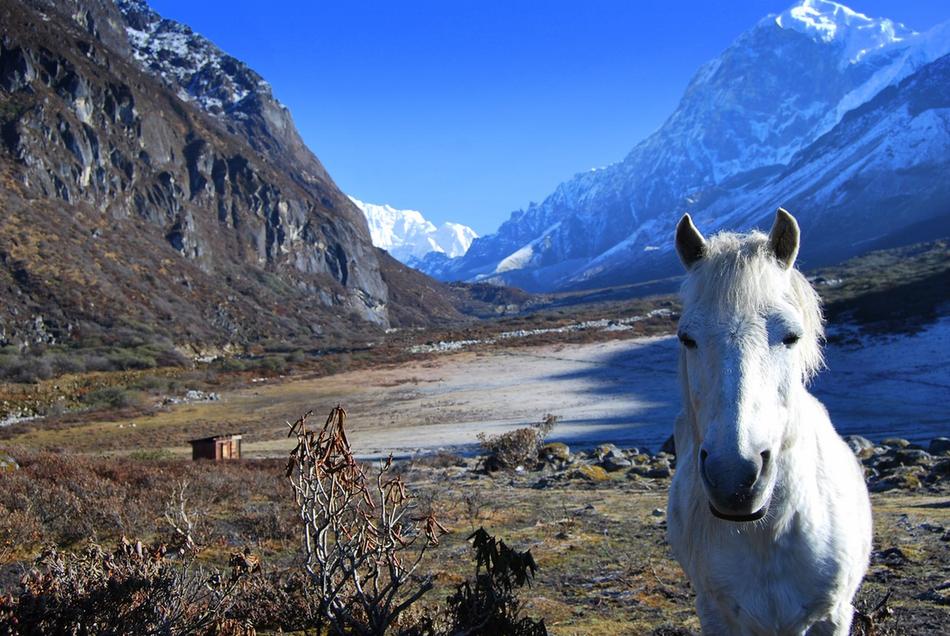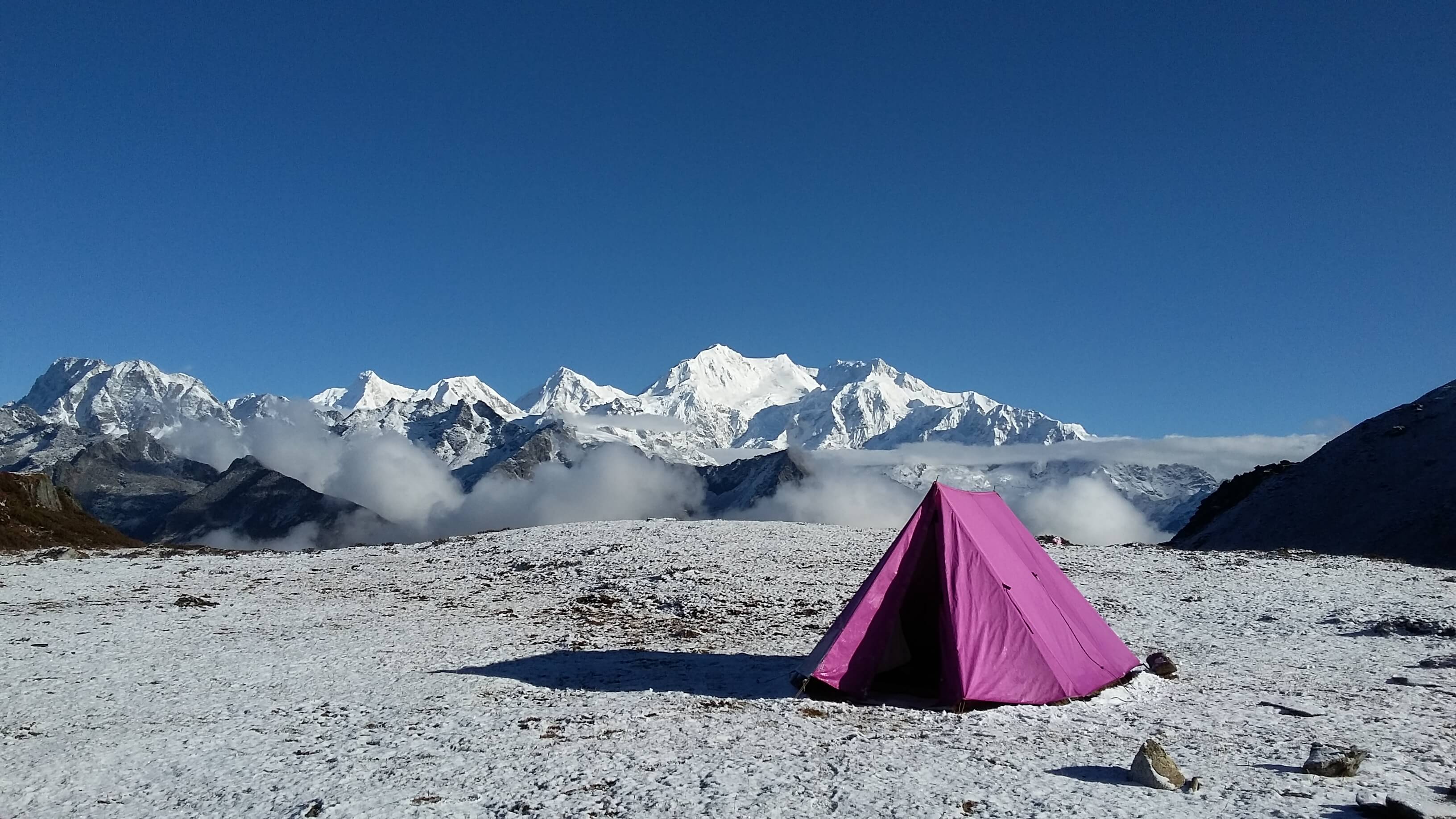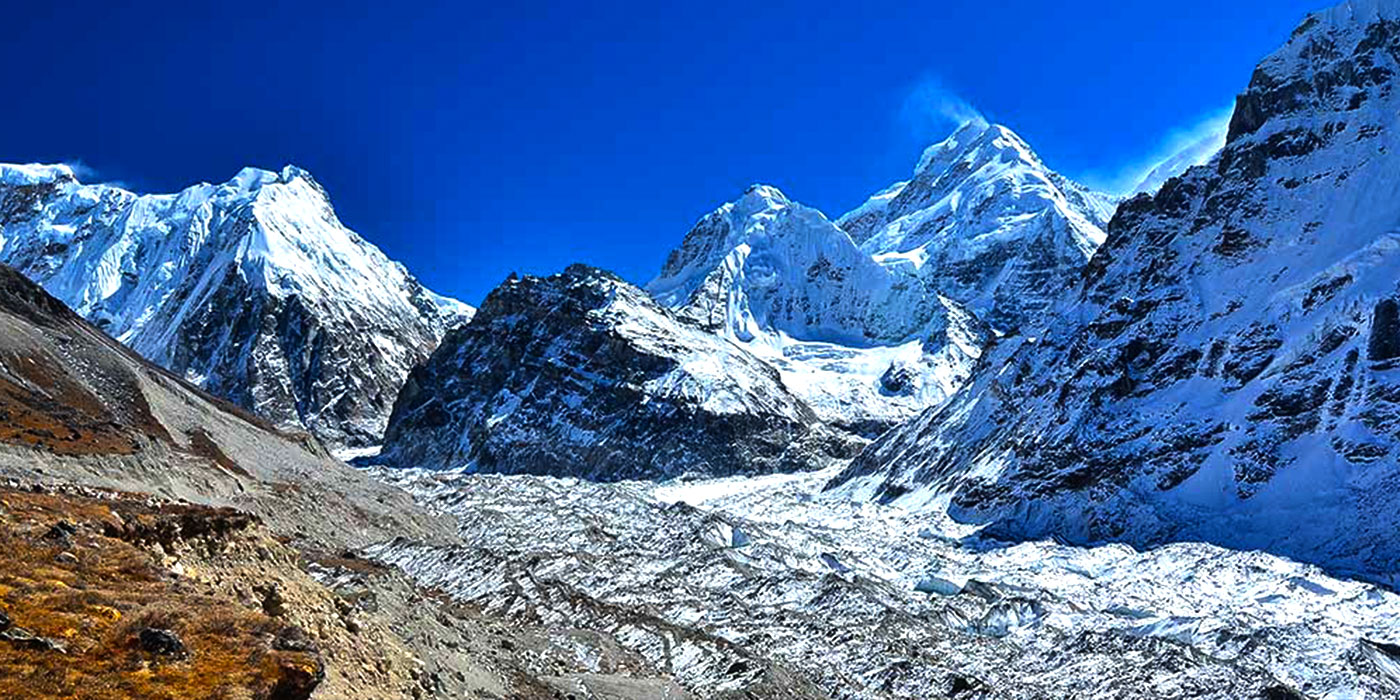Trip Overview
Dafey Bhir Pass or Dafey Bhir La Trek is one of the less explored and pristine trekking trails in Sikkim along the Singalila Ridge which takes you close to the Indo – Nepal border. This trek offers you up close and unparalleled views of Mt. Everest and Mt. Kanchendzonga’s group of mountains. Dafey Bhir in the local language means “Pass of the Pheasant”. The Pass at the height of 4530 meters offers panoramic and stunning views of the entire Himalayan range of Sikkim with views stretching as far as Nepal and Bhutan. The trail during this trek goes through undisturbed dense tropical forest, grassland, meadows, valley, and into the alpine region. Trekkers also have the luxury to camp closer to a few of the most beautiful high-altitude glacial lakes in this trek.
Dafey Bhir trek starts from the village of Uttarey situated at the far western corner of Sikkim and continues along the Singalila ridge bordering Sikkim and Nepal before ending up at Chongri - Nambu village which is an hour drive from the famous hill station of Sikkim, Pelling. The trail during this trek at Singalila ridge goes crisscrossing both the land of Sikkim and Nepal. There are around 10 to 12 high altitude alpine lakes in and around the Dafey Bhir and Uttarey Singalila Goechala trails so this trail is also known as the high-altitude lake trail.
Dafey Bhir and Uttarey Singlila Goechala trekking routes are the same till Lam Pokhari campsite after which the Dafey Bhir route diverts itself towards Yambong, Naya Patal Chongri, and Nambu Village. Further east to Lam Pokhari and Dafey Bhir lies the famous Dzongri and Goechala trekking trails.
The best time to do this Trek is between mid-March, April, May till mid-June and mid-Sept, October till November
Itinerary
- +
Day 1
Uttarey to Chiwa Bhanjyang (3248m/5-6 hrs trek) (Camping) – B/L/D
For eight days we thread our way up and over the highest reaches of the Singalila Range, which forms the border between Sikkim and Nepal. We only meet the occasional yak herders but we are all beyond permanent settlements. The name given to places around here however exotic it may sound to your ear is associated with their purposes, such as high pasture passes and ridge points. We pass through a rich forest cover, swathes of rhododendron, open ridges, sacred lakes, and remote passes. Our first-day trek takes us to Chiwa Bhanjyang (3100 m). An easy trail rises gently through the rainforest until a final steep ascent for the last couple of hours brings us to the Nepalese border and our first camp. Overnight Camping
- +
Day 2
Chiwa Bhanjyang Acclimatization and Phoktey Dara Viewpoint hike (3700m/3-4 hrs trek) (Camping) – B/L/D
Your day starts quite early today as you’re scheduled for a walk to Phoktey Dara in the wee hours of the morning. Phoktey Dara provides one of the most breathtaking panoramic views of the Sikkim and Nepal mountain ranges, as it lies at a junction between Sikkim, Nepal, and West Bengal and the borders meet here. You will have a full view of towering peaks including Mt. Everest, Makalu, Nuptse, Lhotse, three sisters, Kumbakarna, Khanchendzonga, and several other peaks in the region. This is one of the best grandstand views you will get of the majestic Himalayas from anywhere in the mountains. Overnight Camping
- +
Day 3
Chiwa Bhanjyang to Dhor (3800m/6-7 hrs trek) (Camping)- B/L/D
A gentle uphill traversing through the forest and then over a more exposed hillside brings us to prayer flags adorning our first pass and view of a distant mountain - a taste of what is to come. As we gradually gain height, we will appreciate the previous day’s acclimatization. The occasional yak herder’s hut is the only sign of habitation as we look down far below to the rice fields and cardamom plantation. Our camp is in a remote and sheltered hollow below a ridge. Overnight Camping
- +
Day 4
Dhor to Pare Megu (3940m/5-6 hrs trek) (Camping) - B/L/D
Rising just before dawn, a five-minute walk onto the ridge may reveal the spectacular sight of sunrise on both Everest and Kanchendzonga. Throughout the day we descend and climb, maintaining a steady height, spiraling from one side of the ridge to the other until a rough steep ascent takes us across a pass. Beyond, the trail winds its way steadily through rhododendron and past several Hindu shrines where a second easier pass drops down to our camp close to a shepherd’s summer settlement. Look out for a blue sheep on the high craggy mountainside. Overnight Camping
- +
Day 5
Pare Megu to Lam Pokhari (4300m/4-5 hrs trek) (Camping) - B/L/D
We walk easily on a good trail through woods until we begin a steady rise up a broad valley where we catch our first closer view of the entire Kabru range dominated by Mount Pandim (6691 m). A further two hours of ascent will get us to our camp with Everest and a host of other Khumbu giants dominating the distant skyline. An afternoon of rest and acclimatization for the following day’s foot slogging. Overnight Camping
- +
Day 6
Lam Pokhari to Dafey Bhir Pass hike early morning & explore Lakes and return to Lampokhari (4530m/5-6 hrs trek) (Camping) – B/L/D
Today you have to wake up early morning @4 am and head towards the DAFEY BHIR PASS & KAG BHIR LA. You can enjoy the sunrise and breathtaking views of the snow-capped mountain peaks from the pass. The whole range of Mt. Kanchendzonga and Mt. Everest in distance is visible from the pass. Overnight Camping
- +
Day 7
Lam Pokhari to Lower Yambong (3300m/4-5 hrs trek) (Camping) – B/L/D
Today’s trail is mostly dominated by the rhododendron and the primulas which bloom beautifully during May – June. From today onwards we are surrounded by the Alpine vegetation till we get down to Naya Patal and Chongri. Overnight Camping
- +
Day 8
Lower Yambong to Naya Patal (3000m/4-5 hrs trek) (Camping) – B/L/D
The trails go through the temperate forest which habitat numerous wild flora and fauna and at a later point close to the camp gives way to Alpine vegetation. Some of the medicinal plants you can come across in the temperate forest are Jatamasai and the Rhubarb. The Monal Pheasant, Marmots, Red Panda, Blue Sheep, Shapi, and the Tibetan wild-ass are some of the animals that have habitats in these areas and its surrounding. Overnight Camping
- +
Day 9
Naya Patal to Chongri Village/Sang Khola Village (2050m/7-8 hrs trek) (Camping) – B/L/D
Today after breakfast head towards the first settlement village Chongri / Sang Khola. Today it’s mostly downhill through the semi-tropical rain forest till one reaches the village. Overnight Camping
- +
Day 10
Chongri Village/Sang Khola Village trek to Nambu via Village footpath or drive to Nambu Village & further to other locations like Pelling/Yuksam/Gangtok
Depending upon your further plan trek/drive accordingly to your new destination.
Trip Highlights
1) Phoktey Dara Viewpoint - One of the finest viewpoints in the whole of the Singalila range.
2) Highest mountains of the world - Stunning and Panoramic views some of the highest mountains in the world such as Mt. Everest, Mt.Lhotse, Mt. Makalu, Mt. Kanchendzonga, and many others.
3) Sleeping Buddha mountain view - The famous sleeping buddha formation of Mt. Kanchendzonga and its group of peaks is seen from this Trek
4) Rhododendron - Pristine and undisturbed forest of Rhododendrons. Many varieties of Rhododendrons are found.
5) Flora and Fauna - Many endangered and exotic animals and plants are found
6) Less explored Himalayan trail - The particular trekking trail is pristine and less explored
7) Uttarey - A typical Himalayan village settlement and a starting point of Uttarey Chewabhangyang Trek. The Village falls right near the Nepal Border name Chewa Bhangyang.
8) Dafey Bhir Viewpoint - One of the most beautiful and highest viewpoints in Singalila Ridge offering majestic and up-close views of the Mt. Kanchendzonga and several other snow-capped mountains peaks
Health and Fitness
You have to be Relatively Fit and Healthy to undertake the Dafey Bhir trek. Trekking for 4 to 6 hours a day is one of the most important requirements for this high-altitude trek. Apart from good health conditions basic mental preparation is also very important to undertake this Trek.
People suffering from Acute Heart and Lung diseases, Asthma, and High blood pressure are not recommended to take up this trek. However, since this is one of the easiest high altitude trekking routes available with a gradual height gain it can be done with proper professional guidance and preparation.
To complete this high-altitude trek regular exercises like running, skipping, aerobics, Zumba, and long-distance uphill trekking (4 to 5 times a week) are highly recommended. One should start making basic physical preparation at least a month before a trek. These exercises help you during the Trek.
The packing of right and comfortable clothing also makes a difference in the completion of Trek, so it is necessary to be disciplined while packing your clothing for the trip. You can contact us for help with clothing choice and packing!
During the Trek, we provide a basic medicine Kit that includes Medicine for High Altitude sickness, Headache, Diarrhoea, Vomiting, Common Cold, etc. All of our medicine is scientific medicine purchased in India, however, we advised you to bring your small medicinal kit for the trip if possible.
Trekking/Tour Tips
1. A common tendency among young blood and beginners is to show enthusiasm by walking fast with excitement. Even the experienced sometimes try to show off by walking fast, this is soon exhausting and not recommended. Walk slow - warm up gradually and continue at a slow comfortable pace before pushing yourself a little more.
2. Develop a personal rhythm. Maintain your steps to synchronize with breathing. This will help minimize getting out of breath.
3. Walking in Himalayan trails with loose soil and rocks is tricky. So, avoid stepping on loose soil and rocks and place the foot flat and firm with a better grip. Always follow the rule ‘heel first’ while walking on the Himalaya trail.
4. Walking in a zigzags manner while ascending on a very steep slope is advisable. While descending walking zigzag is a good technique to avoid excessive pressure on knees and avoid knee pain and blisters.
5. Avoid stepping on loose stones and soil to avoid an accident.
6. Avoid overtaking fellow travelers on a narrow trail. Only Overtake at comfortable wide space if necessary.
7. While ascending and descending a slope or over loose stones, leave sufficient space between the next person so that any stone rolling down does not hit trekkers below.
8. Do not run down a slope. Bend knees a little while descending. Dig heels into soft snow or soft ground.
9. Our Himalayan condition is mostly wet so avoid wet grass, wet roots, and the muddy zone which can be very slippery. Be careful while walking on them.
10. Shortcuts on a foot trail should be avoided.
11. Always put on warm clothing while taking a rest. This will help avoid getting cold, cough, and high-altitude sickness
12. Respect the sentiments and traditions of the local hill people.
13. Always carry enough water in your water bottle as water is essential in avoiding altitude sickness.
14. Wear a comfortable and right set of trekking boots, pants, and jackets. Avoid wearing new trekking boots directly for the Trek. Get used to it by wearing it before the trek. Carry all necessary clothing.
Halts and Rests:
1. While taking a rest, lie against a tree trunk, a big stone, or on flat ground. Place your legs on your bags or any other higher ground. This helps regulate blood circulation.
2. Stop at any comfortable point after the first start to readjust your rucksack, jackets, or tie a shoelace for better comfort and adjustment.
3. Do not make frequent or prolonged halts. Too many small stops destroy the walking rhythm. Frequent rests are not helpful. You should follow your own rhythmic walking pace and technique to avoid unnecessary tiredness. A stop should be made only at natural stopping points, like on the top of a ridge, or before an ascent, or at a scenic viewpoint.
4. Stop and place yourself on the safer (Mountain) side to give way for the pack animals to pass through. Avoid bags carried by the animals that can push you. Be aware of the yak's horn too.
SERVICES INCLUDED:
1) HIGH ALTITUDE TREKKING PERMITS/PERMISSION
2) LOCAL ENGLISH SPEAKING GUIDE
3) EXPERIENCED LOCAL COOK
4) LOCAL PORTERS
5) PACK ANIMALS
6) 2 MEN TENTS / HUTS
7) KITCHEN & DINING TENTS
8) SLEEPING BAGS
9) MATTRESSES
10) HOT WATER BAGS
11) NATIONAL PARK FEES AND PERMISSION
12) TOURISM FEES AND PERMISSION
13) ENVIRONMENTAL FEES
14) ALL MEALS AND DRINKS THROUGHOUT THE TREK
15) TABLE & CHAIR
16) BASIC MEDICINAL KITS
SERVICES EXCLUDED:
1) INTERNATIONAL AND DOMESTIC FLIGHT TICKETS
2) TRANSPORTATION TO / FRO STARTING & ENDING LOCATION
3) INSURANCE OF ANY NATURE
4) ALCOHOL AND BEVERAGES
5) TIPS AND GIFTS
6) PERSONAL SHOPPING COST
7) ANYTHING NOT INCLUDED IN INCLUDED LIST
FAQ (Frequently Asked Questions)
HOW TO REACH UTTAREY?
The closest Airport and Railway station to Uttarey/Nambu, Sikkim is PAKYONG AIRPORT & BAGDOGRA AIRPORT / NJP Railway station. You have to fly either to Bagdogra Airport or Pakyong Airport or board a train to NJP Railways station. From there you can drive to Uttarey with a private reserve vehicle.
Pakyong Airport is around 7 hours’ drive and Bagdogra Airport / NJP Railways station is around 8 hours’ drive from Uttarey.
WHAT GEARS AND CLOTHING TO CARRY FOR DAFEY BHIR TREK?
No matter what season you are planning for the mountains are always going to be cold, rough, and tough so it is necessary to pack yourself with adequate and proper clothing. Here is the standard kit checklist for the Trek.
Proper packing of the trekking gears is necessary with eyes on the weight limit. It is important to have a good brand of clothing.
Basic Gears:
BackPack & rain cover or Duffel bag (50 to 70 ltr)
Day Pack & rain cover (20 to 30 ltr)
Walking stick (1 pair or at least one)
Water Bottle (2 bottles of 2 ltr each)
Thermos flask (1 nos)
Head Light (1 Nos with 4 pairs of batteries)
Gaiters (1 pair)
Upper and Lower Clothings:
T-Shirt (2 to 3 full sleeves). Mostly noncotton
Fleece T-shirt (1 nos)
Thermal Inner-wears or base layers (1 nos or 1 pair) such as long jones
Fleece Jacket (1 nos)
Down, Feather, or Holofil Jackets (1 nos)
Wind and Waterproof jackets & pants (1 pair)
Trekking Pants (1 pair). Comfortable and durable
Short Trekking Pants (1 nos or 1 pair)
Poncho (1 nos)
Headgears:
Woolen cap (1 nos)
Sun cap (1 nos)
Balaclava or scarf (1 nos)
Sunglasses (1 nos) U/V protected and dark
Hand gears:
Waterproof gloves (1 nos)
Woolen gloves (1 nos)
Feet gears:
Waterproof Trekking boots (1 nos) preferably ankle high Goretex, North face, Colombia or Quechua
Snickers or running shoes (1 nos) preferably from any reputed brand
Gaiters (1 nos)
Sandals or flippers (1 nos)
Cotton socks (4 pairs)
Woolen socks (2 pairs)
Personal utilities:
Sunscreen cream
Moisturizers
Hand sanitizers
Toilet papers and wipes
Anti-bacterial powders
Lip balm
Toothbrush and toothpaste
Proper packing of the trekking gears is necessary with eyes on the weight limit. It is important to have a good brand of clothing.
CAN I EXIT CHONGRI/NAMBU/ ON THE LAST DAY OF THE TREK DIRECTLY?
Yes, you can if you are looking to reach any other location near to these places OR if it is too urgent and necessary. Driving to Airport and Railway directly after the trek is not recommended.
We will advise not to plan to leave CHONGRI/NAMBU directly after the last day of Trek as it will be too tiring and hectic. Driving at night on the Himalayan road is not comfortable and enjoyable.
The earliest you will reach Nambu on the last day of the trek is around 2 pm so long hours drive thereafter is not possible.
CAN I LEAVE EXTRA BAGS AT UTTAREY AND COLLECT THEM ON THE LAST DAY OF THE TREK?
Yes, you can keep a bag of clothes at Uttarey and collect it after the trek. We will advise you to leave one set of clothing for the last day as normally pack animals arrive late on the last day of the trek.
You can even keep valuables and cash at our office safely and collect them after the trek.
WHAT DOCUMENTS NEED TO BE CARRIED?
Indian trekkers must carry identification documents such as VOTER ID CARRD, DRIVING LICENSE, AADHAR CARD, INDIAN PASSPORT. Original documents need to be carried along with 4 pcs PASSPORT SIZE photograph.
Foreigners need to carry INDIAN VISA, PASSPORT & SIKKIM INNER LINE PERMIT along with 4 pcs PASSPORT SIZE photographs.
A medical fitness certificate is also mandatory.
IS THERE CONNECTIVITY DURING THE DAFEY BHIR TREK?
There is no phone connectivity during the Dafey Bhir trek. Uttarey is the last village where you can get a good phone and internet connection.
At certain specific locations between Uttarey to Chiwa Bhanjyang, you can get Vodafone, Airtel, and Jio networks. Even at certain other locations, you can get a phone network if the weather condition is favorable.
There is no electricity throughout the Dafey Bhir trek.
HOW IS THE WEATHER & TEMPERATURE DURING THE DAEFY BHIR TREK?
There are two distinct seasons for doing Dafey Bhir Trek. Mid-March, April to May (Spring) and Mid-September, October to November (Autumn). Normally weather remains good and clear in those given periods however there is no guarantee as weather is extremely unpredictable in our Himalayas and does change within hours and days.
The temperature at each campsite depends largely on each day's specific weather condition.
Spring (Mid-March, April till May)
* Uttarey and around
Morning and Evening – 12 to 16 degrees centigrade
Day time – 18 to 24 degrees centigrade
Late Evening and Mid Night – 8 to 14 degrees centigrade
* Chiwa Bhanjyang and above
Morning and Evening – 4 to 12 degrees centigrade
Day time – 12 to 18 degrees centigrade
Late Evening and Mid Night – minus 10 to 4 degrees centigrade
Autumn (Mid-September, October till November)
* Uttarey and around
Morning and Evening – 8 to 14 degrees centigrade
Day time – 16 to 21 degrees centigrade
Late Evening and Mid Night – 2 to 10 degrees centigrade
* Chiwa Bhanjyang and above
Morning and Evening – minus 8 to 10 degrees centigrade
Day time – 2 to 14 degrees centigrade
Late Evening and Mid Night – minus 15 to 2 degrees centigrade












 Dear
Dear
 Dear
Dear Dear
Dear






